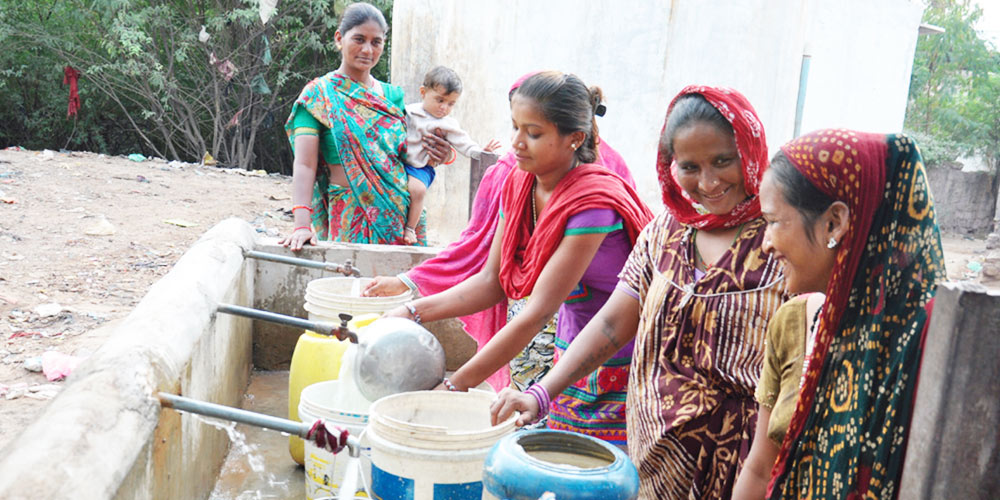India accounts to 31.8% Urban population 377 million (census 2011), and it is expected to grow more than double to 800 million by 2050. This will pose unprecedented challenges for water management in Urban India. 56% of metropolitan, class I and class II cities in India are dependent on groundwater supply either fully or partially for their water demand (NIUA 2005). The increased demands of a rapidly industrializing economy and urbanizing society, limited potential for augmenting water supply, depleting water tables and increasing water quality issues are some of the pressing challenges that currently urban India is facing across the nation. As we drill deeper for water our groundwater quality gets deteriorated and contaminated by total dissolved solids, fluoride and arsenic. Both our rivers and groundwater are polluted by untreated effluents and sewage, continuing to be dumped into them. Many urban stretches of rivers and lakes are over burdened by industrial, sewage and solid wastes. Disturbance in catchment areas and diversion of water channels, illegal encroachments of water bodies for other development uses are the other challenges that makes situation more worsen. Climate change poses fresh challenges with its impacts on geo-hydraulic cycle. Variability of rainfall and lack of proper drainage, more extreme rates of precipitations and evapotranspiration exacerbate situation of floods and droughts.
In India, Water Supply and Sanitation is the state subject and hence the matters relating to water supply and sanitation sector are within the functional domain of state government while role of Central Government is to formulate policies for providing directives and laws and rules for regulations of water resources. Wide 74th Constitution Amendment Act, the further devolutions of functions to provide basic services for water sanitation in urban areas were given to Urban Local Bodies (ULBs). Growing urbanization and poor financial resources has created challenges for ULBs to provide basic services of water supply and sanitation efficiently on regular basis. Poor community participation in urban governance, neglect of traditional water resources, disturbance in catchment area and diversion of water channels; illegal encroachments and conversion of water bodies for other development use; lack of scientific knowledge, inadequate financial resources, lower tax recovery ratio and lack of qualified human resources at ULB level are the major cause of concerns for inefficient service delivery. Furthermore, state managed centralized support for planning and execution of infrastructure development for those services at ULB level has further created dependency on state agencies.
In order to create Infrastructures for Water Supply and Sanitation in Urban areas, state has made adequate financial allocations to ULBs through Central schemes of GoI namely Smart Cities and Atal Mission for Rejuvenation and Urban Transformation (AMRUT) as well as State schemes like Swarnim Jayanti Mukhya Mantri Shaheri Vikas Yojana (SJMSVY) in case of Gujarat to provide support for new source of development and strengthening, harvesting and recharging measures, infrastructure development for distribution network, technology innovation for efficient supply and governance reform. Besides this, in order to provide technical plans and designs for infrastructures to be created, ULBs through state’s support can engage technical agencies to develop city level plans, technical designs and estimates. State and Centre has empanelled resource agencies to impart trainings to build technical capacities of ULBs. Service Level Benchmarks have been developed by GOI to assess the periodic performance of ULBs for its service provisioning. Detailed comprehensive manuals have been prepared by CPHEEO and CPCB in the areas of designing and planning of water supply scheme, water supply management, water quality assessment and treatment, etc.
In Gujarat, “Urban Centres are water deficient! Ground water resources are non-reliable sources for drinking water supply as the quality of groundwater resources are inferior.” These are the general perception all over the State. Furthermore, it also believes that ULBs are incapable of governing their water resources. Providing safe water supply to its citizens is the State agenda hence, connecting most of the Urban Centres with piped network for Narmada Water Supply is the only solution seems sustainable from state perspective. Huge investment on account of distribution network to provide Narmada Water Supply on bulk basis to rural as well urban population and for industries has been made by the State, while for city wide distribution network were supported from Central and State schemes across the states through different schemes since decade. A State level nodal agency called Gujarat Urban Development Mission (GUDM) has been set up to provide technical and financial support to ULBs for creating their infrastructures considering the projected demand of water supply of urban centres.
The work of Arid Communities and Technology (ACT) along with the Bhuj Municipality has revealed that Bhuj city has the water and technologies to make rain and its ground water as the primary source of water; albeit supported during shortage by Narmada waters. The city requires 27 Million Litre per Day (MLD) out of which 56 per cent it receives from groundwater sources, whereas 44 per cent supplemented by Narmada water. The rainwater available to the city is eight times the annual requirement of 9,000 Million Litres, if this water can be harvested and sandstone groundwater recharged, it is possible to solve much of the existing water problems. The city resides on an aquifer of sandstone that is confined in a 100 sq.km. area and is 100 metres deep. The forefather developed three rivers with dams, diversions, and spillways to cover a catchment of 34 sq. km. area. Furthermore, to recycle the grey water for other domestic water needs, Hunnarshala Foundation has demonstrated Decentralised Waste Water Treatment Plant.

